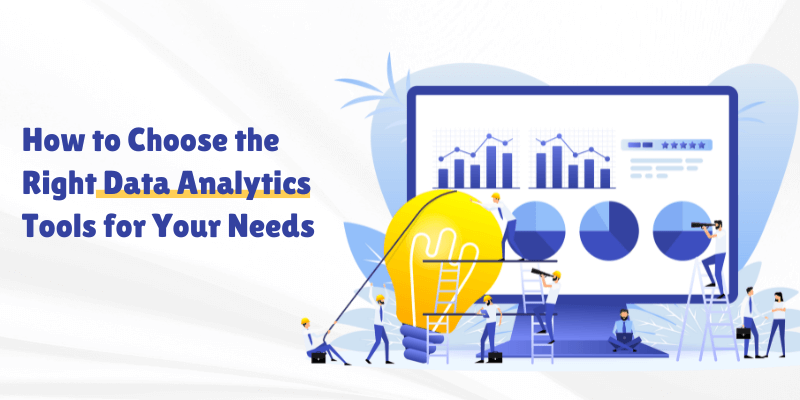How to Choose the Right Data Analytics Tools for Your Needs

Data analytics is a critical component in driving business decisions, uncovering trends, and gaining insights. With the increasing demand for data-driven decisions, it has become essential for businesses to adopt the right tools to collect, process, and analyze data effectively. Choosing the right data analytics tools can be a daunting task, given the vast array of options available in the market. In this article, we will guide you on how to choose the right data analytics tools based on your business needs, objectives, and technical capabilities.
Whether you’re an entrepreneur, a data scientist, or someone exploring data analytics courses in Noida, understanding the features, benefits, and applications of different tools can make a significant difference in your data analytics journey.
What Are Data Analytics Tools?
Data analytics tools are software solutions used to collect, process, analyze, and visualize data. These tools assist businesses in making informed decisions by converting raw data into meaningful insights. With a wide range of tools available, each tool specializes in certain aspects of data analytics, such as data cleaning, data visualization, predictive analytics, or statistical analysis.
Choosing the right data analytics tool depends on your specific needs, the type of data you’re working with, and your team’s expertise. Some tools are suited for small-scale businesses, while others cater to enterprise-level needs.
Step 1: Understand Your Business Needs
Before diving into the world of data analytics tools, it’s essential to have a clear understanding of your business needs. Different tools cater to different functions in the data analytics process, so it’s important to first define your objectives. Here are some key questions to ask yourself:
-
What is the size and complexity of your data?
Large organizations with vast amounts of data require different tools than smaller businesses or startups. If you work with massive datasets, consider platforms that handle big data, such as Apache Hadoop or Spark. -
What type of analysis do you need to perform?
Do you need basic descriptive analytics, or are you looking for predictive analytics or machine learning capabilities? Some tools, like Google Analytics or Excel, are suited for simple reporting and visualization, while others, such as R or Python, are more suitable for advanced data analysis. -
Do you need real-time data processing?
Some businesses require real-time analytics, where data is processed as it is received. In such cases, you may want to choose a tool that supports real-time data processing like Apache Kafka or Power BI with real-time dashboards. -
What is your budget?
Your budget plays a critical role in selecting the right tool. There are free or low-cost options, but they might have limitations in terms of features or scalability. On the other hand, enterprise-level tools might offer more capabilities but come with a higher price tag.
Step 2: Consider the Features of the Tool
Different data analytics tools offer various features that cater to different needs. When evaluating a tool, it’s crucial to consider its key features, such as:
-
Data Integration: The tool should integrate seamlessly with multiple data sources like databases, cloud services, social media platforms, and internal data systems. This helps in pulling data from multiple channels for analysis. Tools like Tableau and Power BI offer robust data integration capabilities.
-
Data Cleaning and Transformation: Data cleaning is a crucial step in the analytics process. Make sure the tool has features that can handle data cleaning, formatting, and transformation. ETL (Extract, Transform, Load) tools like Alteryx or Talend can automate this process.
-
Visualization: One of the most critical aspects of data analytics is visualization. A good analytics tool should provide a wide range of visualizations like charts, graphs, heat maps, and dashboards. Popular visualization tools include Tableau, Power BI, and Qlik.
-
Advanced Analytics Capabilities: For businesses that require advanced analytics, look for tools that support predictive analytics, statistical analysis, and machine learning models. Tools such as R, Python, SAS, and MATLAB are known for their advanced analytics capabilities.
-
Collaboration Features: Many data analytics projects require collaboration between teams or departments. Look for tools that enable team collaboration through sharing, commenting, and version control. Platforms like Google Data Studio and Power BI provide easy sharing and collaboration options.
-
Scalability: Your business might grow, and so should your analytics tool. Ensure that the tool can scale with your data requirements. Cloud-based tools like AWS Analytics or Google BigQuery provide excellent scalability, as they can handle large datasets efficiently.
-
Ease of Use: Consider the learning curve associated with the tool. Some tools, like Excel or Google Analytics, are relatively easy to use, while others, such as R or Python, require more technical expertise. If your team is new to data analytics, it might be better to opt for tools with an intuitive user interface.
Step 3: Assess the Level of Technical Expertise Required
Your team’s technical expertise plays a significant role in selecting the right data analytics tool. If your team is already familiar with a particular tool, that might be a good starting point. However, if you’re new to data analytics, it may be better to choose tools that are user-friendly and don’t require extensive training.
-
Beginner Level: Tools like Google Analytics, Microsoft Excel, and Power BI are excellent for beginners and those who do not have advanced technical skills. They provide enough functionality to perform basic analytics and visualization.
-
Intermediate Level: If your team has some experience with analytics but is not well-versed in coding, tools like Tableau, Qlik, and IBM Watson Analytics offer more advanced features without requiring programming knowledge.
-
Advanced Level: For teams with a solid background in data analytics, tools like Python, R, and SAS can provide advanced capabilities. These tools allow for the creation of complex models and algorithms, but they require familiarity with coding and statistical methods.
Step 4: Evaluate the Cost of the Tool
Cost is an essential factor when choosing a data analytics tool. While some tools offer free versions, they may come with limited features or functionality. Others offer subscription-based pricing models, which can add up over time. When evaluating costs, consider the following:
-
Free Tools: Free tools like Google Analytics or Open-source tools like R and Python can be great for startups or small businesses. However, these tools might require more technical expertise and manual effort.
-
Subscription-Based Tools: Many popular data analytics tools like Tableau, Power BI, and Qlik offer monthly or annual subscription plans. These tools often provide more robust features and customer support but at a higher cost.
-
Enterprise Solutions: If you’re running a large enterprise, investing in an enterprise-level solution like SAP BusinessObjects, SAS, or IBM Watson Analytics might be a good choice. These tools are highly scalable and provide extensive functionality, but they come with a hefty price tag.
It’s crucial to choose a tool that fits within your budget while providing the functionality your business needs. Also, consider the long-term costs, including training, support, and potential add-ons.
Step 5: Read Reviews and Get Recommendations
Before finalizing your decision, it’s essential to read user reviews and get recommendations from others in the industry. Feedback from other businesses or users who have used the tool can provide valuable insights into the tool’s pros and cons. Additionally, consider speaking with consultants or taking courses, such as a data analytics course in Noida, to better understand the tools available in the market and how they compare.
Step 6: Test the Tool Before Committing
Many data analytics tools offer free trials or demo versions. It’s a good idea to take advantage of these offers and test the tool before making a final decision. Testing the tool will help you assess its ease of use, functionality, and compatibility with your existing systems.
During the trial, make sure to:
-
Test Key Features: Focus on the specific features that matter most to your business, such as data integration, visualization, or advanced analytics.
-
Evaluate the User Interface: Ensure that the tool’s interface is intuitive and easy to navigate.
-
Assess Performance: Check the tool’s performance in terms of speed and reliability, especially when handling large datasets.
Conclusion
Choosing the right data analytics tool is a crucial decision that can have a significant impact on the success of your business. By understanding your business needs, evaluating features, considering technical expertise, and assessing cost, you can select a tool that aligns with your goals. Whether you’re a beginner or a seasoned data professional, there’s a data analytics tool out there that can help you unlock the full potential of your data.
If you’re new to the field and looking to enhance your skills, consider enrolling in a data analytics course in Delhi, Noida, Lucknow, Meerut, and more cities in India. With the right training and the right tools, you can gain the insights needed to drive smarter, data-driven decisions in your business.




